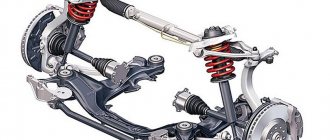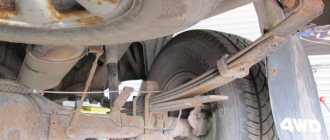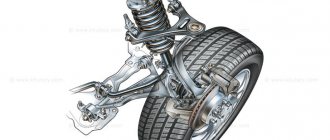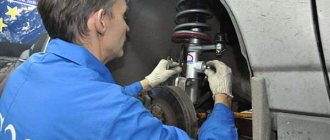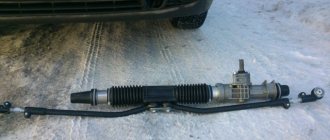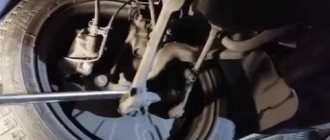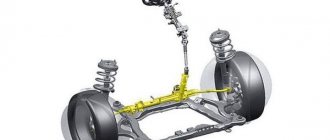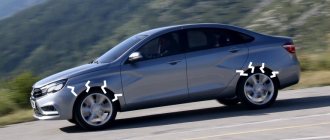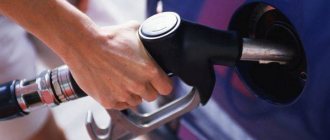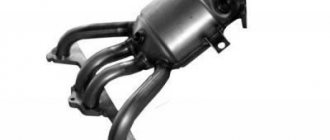If the front suspension of your car is knocking, you have to go to a service center and look for the problem. But the issue is not always resolved during diagnosis. Firstly, the qualifications of the technicians may not be enough to detect the problem. Secondly, some elements of the chassis cannot be checked without disassembly. So you need to learn to look for problems based on the nature of the sound. A knock in the front suspension may occur when hitting bumps. We have already talked about such cases; they are not difficult to find. This type of problem can be found quite simply if you drive into a pit and ask an assistant to shake the car. At this time, it is enough to hold on to various suspension parts or release the silent blocks. This will help you find exactly the part that knocks when hitting obstacles.
If the knocking noise in the forward drive occurs on a flat road, the problem is more subtle. Finding it will not be easy, especially without experience and knowledge in this matter. It should be remembered that knocking can occur in different ways. It is by the nature of the sound that you can often understand what is knocking in your car. However, the concept of a smooth road in Russia is quite relative. So we will consider the issues of knocking of various parts, including sounds on small irregularities and smooth holes on the road. Knocks are also possible on a perfectly flat road. In this case, any rotation element may become unscrewed, which causes a knocking sound simply when turning the wheel. But it’s worth sorting everything out in order. There are a number of reasons that are worth checking if your car exhibits a clunking sound on relatively smooth roads in the suspension area.
CV joints are the main instigators of knocking noises during rotation
Often problems are solved by replacing CV joints. This is a rotary mechanism in the external version and an object of independent transmission of torque in the internal version. If before the mystical knocking sound appeared when turning, you did not hear crunching sounds, then the internal CV joint may be to blame. The outer one fails more often, but before failure it begins to crunch when turning. You can check the part as follows:
- put the car in the pit, turn off the speed and turn on the handbrake for easy access to the axle shafts and other suspension elements in the front of the car;
- check for play on the axle shafts by loosening them from top to bottom or in different directions, then check the play by pushing the axle shaft inside the CV joint and back;
- if there is play, the parts have fallen apart, they need to be replaced, you should buy only high-quality spare parts to carry out the necessary repair processes;
- Before replacing, do not forget to drain the oil from the gearbox, since otherwise it will simply flow out through the holes that appear at the site where the CV joints are installed.
The process of replacing internal CV joints is quite complicated. Interestingly, the main reason for parts failure is a torn boot. A part that costs a hundred rubles damages an expensive mechanism that is very difficult to replace. So it is worth monitoring the condition of the anthers and always changing them if necessary.
How to check a support bearing
There are three methods for checking the support bearing at home: Remove the protective caps and press the upper element of the front strut rod with your fingers. Now we begin to rock the car from side to side by the wing. We do this both longitudinally and transversely. If the bearing fails, you will hear the same knocking noise as when driving. At the same time, the car body will swing, but the pillars will either stand still or swing with less amplitude.
You can place your hand on the front shock absorber spring coil. Then you need to turn the steering wheel in different directions. For this you will need an assistant. If your hand feels a recoil and a metallic knock sounds, things are bad with the bearing. You can also drive first on a flat road, and then on a rough one, and listen to what sounds the car makes. If you hear metal knocking from the front arches under extreme loads, then the problem is most likely in the support bearing.
It is worth understanding that partial or even complete failure of the support bearing is not a critical failure for the car. However, this does not mean that you can safely drive such a car. In addition, in domestic realities it is better to carry out diagnostics every 10-20 thousand km.
And it doesn't matter whether there are signs of malfunction or not
You need to maintain your car regularly, otherwise you can become an example of careless and dangerous “care” for your car. And that's not very fun.
https://www.youtube.com/watch?v=VLNGuUsv4DM
To avoid serious damage to car systems, you should pay attention to the slightest knock or creaking noise under the hood. If you stubbornly ignore seemingly minor signs of malfunction, then serious problems cannot be avoided.
In particular, this is a knocking sound when turning the steering wheel. It may indicate a faulty front strut upper support bearing.
The front strut support bearing is an important part of a car's suspension. Unfortunately, most drivers pay minimal attention to the health of their suspension systems. But in vain, given the state of domestic roads and, sometimes, the low quality of parts that are installed on modern cars. But it is the suspension that is responsible for car handling and road safety.
Its maintenance is complicated by the variety of parts, and they all perform their functions: brackets, springs, shock absorbers, and so on. In this article we will talk specifically about the support bearings of the front strut, since these parts are subject to increased wear and often fail.
Ball joint - knocking in the suspension of different characters
There is a part in the car suspension that is difficult to check. If it knocks, it happens precisely on small and unnoticeable irregularities. The ball loses its lubricant and begins to move very difficultly inside the seat. This causes sounds like creaking, light knocking, and annoying rattling. An element fails for the following reasons:
- just natural wear of the part, which occurs every 100,000 kilometers; during operation, the mechanism wears out, lubricant comes out, and efficiency decreases;
- the support begins to knock quite unexpectedly, the intensity of the sounds quickly increases, so it is better to promptly replace the element;
- when installing a low-quality support, a not very pleasant process occurs - after a few thousand kilometers, extraneous sounds appear that are unpleasant to listen to;
- Also, a torn boot is one of the main causes of problems in this part of the car, so you should constantly look at the rubber bands and their integrity.
The ball joint is very difficult to diagnose. To check it, it must be removed, which cannot be done without the help of a professional service. That is why they often do not sin on it when going through other suspension parts. It may well happen that you change half of the suspension until you get to the knock directly in the ball joint.
Kalina knocking on bumps in front
This is what the assembled Kalina front suspension looks like
Poor condition of the road surface and low-quality spare parts can be one of the reasons for knocking in the suspension. Another important problem is wear. This reason occurs quite often, especially when the car owner does not carry out maintenance or diagnostics of the suspension in a timely manner.
Causes and treatments
In the table we will look at what specific reasons can cause a knock in the suspension, as well as how to eliminate these breakdowns.
Struts and strut supports are a problem for every car
Even high-quality and reliable racks begin to struggle with unevenness and knock after prolonged use. For a Chinese spare part, a long service life of 1000 kilometers is considered, for an original Japanese or European one - 15-20 thousand. Struts and upper supports regularly fail on cars in Russia, and the reasons for this can be very different:
- the strut itself rarely fails completely; when the car is rocking, creaking and extraneous sounds will be heard, and the knock will be heard throughout the entire suspension at once;
- the support in most cases fails at the moment when the support bearing breaks, this happens in the event of a sudden collision with large uneven roads;
- Perhaps a simple tightening of the support or shock absorber fastening at the top point will help you; you need to check all fastening elements;
- If the struts break down, they may leak, which will be visible on the body, but this is not a prerequisite, but simply a recommendation for additional diagnostics of the suspension element.
Operating principle
On the Lada Kalina, MacPherson suspension has improved ride quality. Starting with Kalina, all new AvtoVAZ models began to be equipped with MacPherson strut suspension. When driving, the level of impact of a bad road on the body is much more effectively reduced, making driving a car much more comfortable than, for example, a VAZ 2109, where a similar type of suspension is installed.
Thus, the independent MacPherson suspension consists of two axle shafts, allowing the wheels to be practically independent of each other. This means that the wheels, when one of them hits a bump, a depression or something else, do not change the level of inclination, as is the norm in semi-independent and dependent suspensions.
Differences between the front suspension of Kalina and previously produced AvtoVAZ cars
All AvtoVAZ cars had a MacPherson strut suspension at the front, but it was significantly different from those used in the 70s, 80s and 90s by Ford, Fiat, Volkswagen, etc. So, the main differences between the MacPherson strut suspension and the suspensions of Lada models until 2004 are concluded as follows:
- Instead of a bearing, a bushing is mounted in the MacPherson.
- In MacPherson, the ball bearing has a larger radius, and the design also differs. Now it is located in the upper part between the support and the spring element in a compressed state, which perfectly helps to remove knocks when moving.
- When the wheels turn, the front suspension strut, or rather its body, rotates with the spring simultaneously. When this happens, the shock absorber rod remains motionless.
The steering rack is a quiet, separate element with sophisticated diagnostics
It often happens that after reassembling the entire chassis, it is time to check the steering rack. By moving the steering wheel left and right, you will hear small knocks if the rack has already begun to wear out. But this does not mean at all that it knocks during operation. It is difficult to give general recommendations here; there are different recommendations for owners of different cars:
- It’s worth visiting specialized forums and reading information about how and when the steering rack fails, how you can check and fix it;
- tightening the steering rack is a solution for a few days; soon it will start knocking again if a problem is identified with this particular element of the car;
- the knock of the rack is often a distinct feedback on the steering wheel, as well as on the body in the area where the control pedals are attached, so diagnosis will not be difficult;
- Sometimes steering tips or rods knock, which is more difficult to check, but you can perform a full diagnosis in a pit without any problems or inaccuracies.
The steering system likes to knock in domestic cars, as well as in cars older than 10 years. Changing the steering rack is very difficult due to the high cost of spare parts and the rather inconvenient location in many cars. Therefore, they prefer to perform this process on a service. Professionals will complete all tasks quite simply and quickly.
Silent blocks in the front of the car - replacement check
A very important element of the front suspension, which can knock in the most unusual way, is a set of silent blocks. The most common knocking sounds are the rear silent blocks of the front suspension arms, as well as the support silent blocks of the stabilizer, which are attached to the body. The whole problem is solved by replacement, there is no point in diagnosing for a long time - it is better to change the part. Failure occurs for the following reasons:
- the rubber simply breaks due to increased loads, it does not withstand too much pressure and is deformed under the influence of the connections of the suspension arms;
- The silent block stops turning freely in the right place, there is no flexibility in the suspension, and the levers knock due to the lack of the required maneuver;
- the rubber has worn through, worn out and decreased in size, so metallic sounds are heard from the chassis, which are difficult to diagnose;
- It is necessary to pay attention to the fastenings of silent blocks; often replacing them turns out to be difficult due to preliminary unskilled work with suspension parts.
You can check while driving whether the rear silent blocks of the front control arms are knocking. You need to place your foot directly on the floor and listen to whether there is a knock on your foot. The same procedure should be done on the passenger seat. The stabilizer support bushings are checked by placing your foot or hand on the part of the body behind the pedals. However, if you have suspicions, you can simply change this element. We invite you to watch a short video with self-diagnosis of the Hyundai Solaris suspension:
What other components cause knocking?
If you have checked all the components described above, but have not found out the cause of the knocking, pay attention to the stabilizer bushings. As a rule, their wear is accompanied not only by knocking on bumps, but also by squeaking. By the way, it is for this reason that the rear suspension most often creaks.
On some cars, such as the Ford Focus or Renault Duster, the engine mounts are a whole mechanism with rubber bushings. Therefore, the knocking noise may be caused by wear of the bushings. Malfunctions of the supports can only be determined visually by carefully inspecting all engine mounting components.
We are on social networks and messengers: ★ Vkontakte group: ► https://vk.com/oo_dk ★ Facebook group: ► https://www.facebook.com/groups/oo.dk.kz/ ★ Odnoklassniki group: ► https://ok.ru/group/55161239502972 ★ Instagram group: ► @road_control_kz ★ Telegram group: ► @oo_dk ★ WhatsApp group: write to WhatsApp and you will be provided with a link to our group ► 8-777-154 -37-77 ★ Periscope: ► https://www.periscope.tv/denizshima/1kvJpnNgVEMKE?
Cooperation and advertising: ★ COOPERATION: ► ★ WhatsApp: ►8-777-154-37-77
For monitoring police activities: ★ MASTER Card: JSC “Kaspi-Bank”: No. 5169 4931 3301 9524 ★ Qiwi wallet –
Let's sum it up
It is worth using various methods to test equipment before replacing. Otherwise, because of one knock, you can change half of the suspension without eliminating the cause of the problem. Therefore, you should always approach diagnostics from different angles and use the services of testing suspension parts at several service stations. You can change parts only if you are sure that certain mechanisms are faulty. You should approach the issue of repair with full understanding so as not to spend too much money on this process. Many novice drivers simply buy every part that they are guilty of, and as a result, repairs are very expensive.
There are certain difficulties in diagnosing the chassis of a modern car. It is not at all clear which element may be causing the knocking. There are a number of possible options, they are all interconnected, and even analysis does not answer the question. Therefore, it is very difficult to use the full picture of the breakdown to purchase the spare parts necessary for repair. Sometimes you have to change parts just at random, not getting the result on the first try. There are various repair options available, but to do so you need to pinpoint the problem. How do you usually diagnose and repair the chassis of your car?
A knock in the front suspension on small bumps is one of the signs that some of the chassis parts are damaged or almost completely worn out. Novice motorists, without much hesitation, take their car to a service station for diagnostics and shell out considerable sums for repairs. However, there is no guarantee that the knocking will disappear and its source will be found. You can not only identify but also eliminate most of the causes that cause knocking on your own.
Posts 1 to 25 of 63
1 Topic by anatolii 01/31/2015 18:01:39
- anatolii
- Participant
- Inactive
- From: Degtyarsk (Ekaterinburg)
- Messages: 38
- Thank you: 2
Topic: Knock in supports
I have the first one with a larger hole, there is a metallic knock, as they say, “the stand is falling”? On a speed bump too, if you drive a little faster, then with such a blow the wheel falls off. How do you fight this?
2 Reply from .gsm 01/31/2015 18:25:33
- .gsm
- Newest Member
- Inactive
- Messages: 2
- Thank you: 0
Re: Knock in supports
I have a mileage of 1000 km on bumps, the rear strut seems to be knocking, I'm waiting for 2000 km
3 Reply from anatolii 01/31/2015 18:29:43
- anatolii
- Participant
- Inactive
- From: Degtyarsk (Ekaterinburg)
- Messages: 38
- Thank you: 2
Re: Knock in supports
I have a mileage of 1000 km on bumps, the rear strut seems to be knocking, I'm waiting for 2000 km
4 Reply from 7TT 01/31/2015 18:55:02
- 7TT
- Participant
- Inactive
- From: Orenburg
- Messages: 690
- Thank you: 58
Re: Knock in supports
I have a mileage of 1000 km on bumps, the rear strut seems to be knocking, I'm waiting for 2000 km
Check the top nut first.
5 Reply from max-xx 01/31/2015 20:04:45
- max-xx
- Moderator
- Inactive
- From: Moscow
- Messages: 2,886
- Thank you: 375
Re: Knock in supports
Pull the pendant to start. I didn’t notice any iron in myself in the indicated situations. Yes, the suspension worked. but without unnecessary overtones. Mileage 7.5 t.km.
6 Reply from Vadyai 01/31/2015 23:26:22
- Vadyai
- Participant
- Inactive
- From: Ulyanovsk
- Messages: 77
- Thank you: 4
Re: Knock in supports
I have the first one with a larger hole, there is a metallic knock, as they say, “the stand is falling”? On a speed bump too, if you drive a little faster, then with such a blow the wheel falls off. How do you fight this?
This is normal, the struts hit the return line - you need to drive more carefully.
7 Reply from 7TT 01/31/2015 23:46:33
- 7TT
- Participant
- Inactive
- From: Orenburg
- Messages: 690
- Thank you: 58
Re: Knock in supports
This is normal, the struts hit the return line - you need to drive more carefully.
This is not normal!, - the racks should not be hit either forward or backward, - ammas for replacement.
8 Reply from .gsm 01-02-2015 13:24:41
- .gsm
- Newest Member
- Inactive
- Messages: 2
- Thank you: 0
Re: Knock in supports
yes rear right. fastening nut inspected and tightened
9 Reply from denisl56 01-02-2015 14:11:31
- denisl56
- Participant
- Inactive
- From: Orenburg
- Messages: 637
- Thank you: 46
Re: Knock in supports
On Kaliny, this is everywhere, the design highlight of SAAZs.
10 Reply from vl116rus 01-02-2015 14:41:04
- vl116rus
- Participant
- Inactive
- From: Tatarstan Nizhnekamsk
- Messages: 802
- Thank you: 129
Re: Knock in supports
On Kaliny, this is everywhere, the design highlight of SAAZs.
I confirm that the sound is the same on the DOSH.
11 Reply from anatolii 01-02-2015 15:06:35
- anatolii
- Participant
- Inactive
- From: Degtyarsk (Ekaterinburg)
- Messages: 38
- Thank you: 2
Re: Knock in supports
I have the first one with a larger hole, there is a metallic knock, as they say, “the stand is falling”? On a speed bump too, if you drive a little faster, then with such a blow the wheel falls off. How do you fight this?
This is normal, the struts hit the return line - you need to drive more carefully.
Where else can you be more careful? Speed on recumbents 15 mph maximum. And it turns out that the roads in our town are not particularly bad, and you need to drive 10 km/h? It seems like I haven’t seen any such riders. Why such a car with such a suspension, on which I can only drive as quietly as a turtle without knocking.
12 Reply from anatolii 01-02-2015 15:12:42
- anatolii
- Participant
- Inactive
- From: Degtyarsk (Ekaterinburg)
- Messages: 38
- Thank you: 2
Re: Knock in supports
yes rear right. fastening nut inspected and tightened
I also confirm this knock, from the rear right! On TO-0, “not detected” was noted everywhere. They didn’t seem to find a knock in front, a knock in the back, a howling transmission, or a gap in the hood where a finger slipped through with a whistle. So don’t put too much hope that MOT will get rid of it for you.
13 Reply from max-xx 01-02-2015 16:18:22
- max-xx
- Moderator
- Inactive
- From: Moscow
- Messages: 2,886
- Thank you: 375
Re: Knock in supports
I pass the police without worrying about 20 and a little higher. Pits earlier, after Matiz, with caution. Now how will it work out. Almost all cars have questions for the rear amams, I won’t write about Matiz. there is slag coming from the factory. It seems to me that we are escalating this issue. For me, the pendant came out quite decent.
14 Reply from anatolii 01-02-2015 16:39:38
- anatolii
- Participant
- Inactive
- From: Degtyarsk (Ekaterinburg)
- Messages: 38
- Thank you: 2
Re: Knock in supports
I pass the police without worrying about 20 and a little higher. Pits earlier, after Matiz, with caution. Now how will it work out. Almost all cars have questions for the rear amams, I won’t write about Matiz. there is slag coming from the factory. It seems to me that we are escalating this issue. For me, the pendant came out quite decent.
Duck here on police stations and pits the knocking is hard in front, but in the back when driving there is such a small knocking noise that is unpleasant
15 Reply from max-xx 01-02-2015 16:59:26
- max-xx
- Moderator
- Inactive
- From: Moscow
- Messages: 2,886
- Thank you: 375
Re: Knock in supports
I hear work ahead as I drive by. I don't consider this a crime. No clang, no knock. Keep in mind that we have gas and meat. And this is tougher.
16 Reply from anatolii 01-02-2015 17:22:38
- anatolii
- Participant
- Inactive
- From: Degtyarsk (Ekaterinburg)
- Messages: 38
- Thank you: 2
Re: Knock in supports
I hear work ahead as I drive by. I don't consider this a crime. No clang, no knock. Keep in mind that we have gas and meat. And this is tougher.
Those. nevertheless, this is the case for everyone and this knock is called “rack work”?)))
Source: datsun-do.ru
List of the most common reasons
Knocking in the suspension when driving over uneven surfaces is an extremely common problem. In most cases, the sound that appears when the body vibrates when a wheel hits an uneven surface is associated with partial performance of the chassis, but occasionally there are other reasons. The most common reasons are:
- faulty shock absorber strut mounts;
- damage to shock absorbers or their individual elements;
- wear of ball joints, silent blocks, support bearings;
- damage to the steering rack.
These are the most common causes of metallic knocking noises coming from under the car body. Defective suspensions are much less common. Sometimes the engine support components are to blame. Each individual problem is solved in its own way, but most often you simply have to replace the damaged part. The most common cause of the problem is wear of components due to poor quality roads. Since most foreign cars simply do not have any additional chassis protection systems, silent blocks, supports and other elements suffer, which bear the brunt. While reducing damage to the body and other parts of the car, these elements themselves wear out, and very intensively.
First of all, it is worth checking them and replacing them if a malfunction is detected.
You should definitely not repair damaged parts yourself; they must be replaced with factory equivalents. You shouldn’t ignore the problem either, because the longer the knocking continues, the more extensive the damage will be in the end. Try to quickly check all possible causes, and this should be done in this order.
Kalina knocking on bumps in front
Many of us, when purchasing a new Lada Kalina, probably noticed that when driving over small irregularities on the asphalt, and especially on a dirt road, there are small annoying muttering sounds reverberating through the body of the car. These sounds are especially audible when the window on the driver's side or on the right side is open. I wondered how to eliminate this shortcoming? After looking through the entire Internet and reading several forums, I began to experiment with the upper support of the front suspension strut: 1. I noticed that the cup of the upper support (limiter) did not fit tightly to the damping rubber of the support itself. I concluded that it needed a better fit and placed a rubber gasket under the cup of the upper support, cut in the form of a ring, and the cup (limiter) began to fit tightly through the rubber to the support body. The first trip showed a SEVERAL TIMES INCREASE in the VIBRATION TRANSMITTED TO THE BODY FROM THE SHOCKER. 2. I thought that things wouldn’t work out that way and began to figure out what was going on. It turns out that the cup of the upper support (limiter) should structurally touch the damping rubber only during rebound, i.e. when the wheel falls sharply down and has reached the limit of the stroke of the shock absorber rod, that is, during normal operation, the rubber damper to which the shock absorber rod is attached should work and the cup should not touch the rubber. 3. In short, I thought about it and decided to do this: I placed a 2 mm thick washer under the cup of the upper support (limiter), it turned out that now the cup does not touch the upper support and the gap between the cup and the rubber is about 2 mm. The trip showed that all sorts of knocks and noises from the front suspension when driving on a bad road immediately decreased. So let's get down to action:
1. Unscrew the nut securing the front strut shock absorber.
2. Take out the metal cup (LIMITER - according to the KALINA parts catalog).
3. WE START ASSEMBLY BACK, BUT before that we place (put) a washer on the shock absorber rod (under the cup) with a thickness of 2-3 mm. Before placing the washer, you need to sharpen the edges, otherwise the edges of the rubber will be eaten by this washer or find hemispherical washers. The dimensions of the washers are as follows: outer diameter 25-34mm, inner diameter 14-15mm. I installed hemispherical washers, they are located on the “classic” - on the top bolt of the front suspension, they press the silent blocks. Outer diameter – 38.5 mm, inner diameter – 14 mm. ,thickness 2mm. Sold in all auto parts stores. The issue price is 10 rubles/piece.
Replacing silent blocks
A dull knock in the front suspension usually occurs due to problems with silent blocks and springs. If the reason is silent, then the car's handling will noticeably deteriorate. The only option is to replace the entire set. There is only one way to check whether this is true - carefully examine the front suspension arms. To do this you will need a mount. Using a pry bar as a counterweight arm, bend each front suspension arm. You need to bend in different directions. If there is a malfunction, you will find play, which is why the knocking occurs.
If you can disassemble the structure, then all that remains is to replace the silent blocks in the following sequence:
- Remove all levers.
- Next you need to pull the silents out of their seat. Using a special mandrel they can be easily pressed out.
- Clean the seat from any remaining oil and dirt.
- New silent blocks must be lubricated with machine oil before installation.
This, in fact, is all that is required of you.
The rear suspension suffers less from this problem, since the main load falls on the front suspension due to the motor assembly. Nevertheless, it is worth checking the condition of the silent blocks in both parts of the chassis.
Suspension device Lada Kalina
The suspension includes coil-type and conical springs, they are not in the photo. The springs are located above the suspension strut. Thanks to them and the shock absorber, the car's ride and handling are ensured. The spring is made of steel with a low carbon content; it softens shocks, bumps and bumps. When the car hits an obstacle, the wheel becomes virtually completely out of control, which is a problem. A spring is needed to return the wheel to its place. A shock absorber is necessary to dampen vibrations after the wheel returns to its normal position. The front suspension arm removes the roll and holds the wheel on itself, and the front suspension arm is also an element of setting the wheel in its place when hitting obstacles. The SPU strut is necessary to connect the body and suspension. This element equalizes the vibrations of the body and suspension, which allows the car to move without problems with tilting when turning.
Steering rack
A knock in the suspension when turning can occur due to problems with the steering rack. Typically, it is the turning of the steering wheel that causes the sound, which occurs due to play inside the structure. A characteristic feature is that the sound comes from one side and is also accompanied by a noticeable vibration of the steering wheel. The malfunction is especially pronounced on a gravel placer, then vibration is very frequent, although there should not be any at all.
The sound occurs when the steering gear and the rack itself rub against each other.
Occasionally, a similar defect is observed immediately after replacing the bearing in the hubs of VAZ 2109. As a result of the defect, the backlash will increase, which will lead to damage to the elements of the steering structure. To verify the reason, you will need a jack to raise the car:
- Raise the car.
- Take a pry bar and carefully move the tie rods from side to side.
- If significant play occurs (it should be visible to the naked eye), then the problem is worn out bushings that will need to be replaced.
- It is also necessary to tighten the rack nuts to seat it on the gear.
It is rare, but it still happens that the steering wheel and its components are in order, but vibration and knocking are still present. In such cases, attention should be paid to inspecting the steering joints.
Balloons are no joke
The cause of knocks and squeaks is often wear and tear on the ball joints. This is a very important part in the form of a hinge that connects the wheel hub to the suspension arm. True, ball joints usually knock only on rear-wheel drive cars with a simple suspension. On front-wheel drive vehicles, the malfunction manifests itself in the form of a squeaking sound. The exception is cases when wear reaches a critical value, i.e. the hinge begins to simply dangle in the body.
To verify that the ball joint is faulty, you need to hang the wheel, press the brake pedal and try to turn the wheel left and right. If there is play and knocking, then the ball needs to be changed. It must be said that in some cars, such as the Lada Granta or VAZ 2110, the ball joint is bolted on, so replacing it is not difficult. But sometimes there are supports that are pressed into the lever (Mercedes CLS W219 or SsangYong Rexton). Accordingly, they are replaced along with the lever, even if it is still in good condition.
If no play is detected, you need to check the condition of the boot. The fact is that often the cause of noise in ball joints is dirt getting under the joint. Therefore, you need to add lubricant to the hinge and replace the boot.
A rupture of the ball joint (tearing out the hinge from the body) can cause an accident, since in this case the wheel turns out and the car falls on the asphalt. Therefore, when the first signs of wear appear, it must be changed.
Racks, supports, springs
A strong knock in the front suspension occurs due to impacts on the car body. This happens when the shock absorption system wears out. In rare cases, the shock absorber spring can also be the culprit of the knocking, but this happens extremely rarely, since the springs are the strongest part of the assembly.
The sound occurs on small bumps when the shock absorbers take a sharp blow. The vibration damping system copes very poorly with such an active load, so rapid wear of the elements during frequent driving on uneven roads leads to such consequences. The result is wear of the rubber layer of the support.
To detect a malfunction, you will have to go through the entire rack, remove it along with the support, and for this you need to dismantle the wheel and partially disassemble the chassis. There will be a lot of work. To make sure it is the strut support that is the problem, you need to measure the distance from the support to the rubber stopper. Ideally, there should be no discrepancies, maximum 1–2 mm.
If the reading is higher, you will have to replace the rubber layer of the strut.
If you don’t want to do this yourself, then the service station will do this work much faster, albeit for a fee. Vibration and knocking should disappear immediately after replacement.
It is extremely rare that the cause of a knock is the rack itself, which has become severely worn out due to constant loads. The sound will be very loud, and the car will shake considerably on bumps.
Checking the strut is quite simple: press harder on the hood. If the rack is faulty, the car will sharply return to its original position with a characteristic loud knock, while the body will sway a little.
The source of the sound may be a loose nut inside the mechanism that can be tightened.
Well, the latest option is a complete malfunction of the shock absorber mechanism. This happens as a result of accidents and collisions. At first, no attention is paid to the knocking, but the problem is discovered much later.
Diagnostics of the condition of components and troubleshooting
After carrying out a visual inspection of the suspension of the Lada Kalina, which will allow you to find out the cause of the knocking, you can proceed to dismantling the faulty elements. For example, car shock absorbers. Diagnostics are carried out by placing the car over an inspection hole or using a jack. Particular attention is paid to elements adjacent to the body or car frame.
Diagnostics involves a thorough examination of the suspension elements, the presence of various damages, cracks and breaks on them. If a breakthrough is detected in the rubber protection of the steering tip, it must be repaired. Rubber seals are inspected for mechanical damage and those areas where there are breaks and cracks are identified.
As a result of a muffler breakage, a knock will be heard in the suspension. To identify the cause of such sounds, which may lie in the exhaust pipe, the muffler should be rocked in different directions. This is a quick way to diagnose the front suspension. After this is completed, you can proceed to suspension repair.
The chassis of a Lada Kalina car, like any other, must be in good condition, which will ensure safe operation of the vehicle.
The front suspension consists of: 1 — nut for securing the upper strut support; 2 - bolt; 3 — upper support of the front suspension strut; 4 — bearing of the upper support of the strut; 5 — upper insulating gasket of the spring; 6 — front suspension spring; 7 — protective casing; 8 — telescopic stand assembly; 9, 10 — nuts securing the strut to the steering knuckle; 11 — bolt with eccentric; 12 - bolt; 13 — steering knuckle; 14 — front wheel drive shaft; 15 — stabilizer bar; 16 - stretching; 17 — lever; 18 — ball joint; 19 — hub; 20 — hub fastening nut; 21 — brake disc; 22 — front suspension compression buffer; 23 — upper spring cup; 24 — compression stroke limiter of the upper strut support; 25 — travel limiter of the upper strut support; 26 — stabilizer strut mounting nut; N - reference size
It is possible to eliminate various malfunctions that occur in the front suspension of the Lada Kalina car if their cause is known. If there are faulty front suspension struts that can knock, they should be replaced. In some cases, they can be repaired.
If during the diagnosis it was revealed that the bolts that secure the stabilizer bar that provides lateral stability to the car body are loose, then they need to be tightened. Worn rubber or rod pads are replaced.
If the fastening of the upper support of the Lada Kalina suspension strut is loose, then it is necessary to tighten the nuts securing this unit. If the front suspension exhibits destruction of the rubber support of the strut, then it must be replaced. If the rubber-metal hinges (silent blocks) are worn out, new ones should be installed.
Other reasons
In addition to all the options described above, the suspension also knocks for other reasons. One of these is brake pads that produce a metallic knock. In such cases, the sound disappears as soon as the brake pedal is pressed. Often this problem occurs after installing new elements or severe wear of old pads.
Any knocking noise in the rear suspension can repeat the problems described above, but this happens extremely rarely due to the fact that most modern car models are front-engined. Since the engine is one of the heaviest parts of the car, the front part of the body bears much more load, and even shock absorbers do not protect against this. The rear of the car is unloaded, and therefore is not subject to such problems.
By the way, knocking noises in the front end may be the result of a worn engine mount.
The rubber inserts of the unit wear out over time, this happens after about 100–120 thousand kilometers of a new car. As a result, when the rubber parts are worn out, any trip on an uneven road will be accompanied by a metallic knock. Additional sound can be produced by the motor itself, the unit of which will be slightly displaced. If the reason is in the support, then you will find carbon deposits on the spark plugs, and when you inspect the support itself, you will find tears.
Brake pads
On uneven roads, the brake pads may knock or rattle over bumps.
On VAZ 2101 - 2107 cars, pressure springs are provided (popularly called “gulls”), which are designed to hold the pads and press them against the caliper and guide pins so that they do not rattle when driving over bumps and holes.
Over time, these springs lose their properties, as a result of which knocking noises can be heard in front of the suspension.
To check this while driving, press the brakes; if the drumming disappears when rolling, it means the brake pads are knocking.
On other cars you also need to look at either the pressure springs or the petals; they can either fly off or lose their properties over time. Only replacing them can save the situation.
Causes of extraneous noise and knocking
There can be plenty of reasons for extraneous noise and knocking in the front suspension. When parts wear out, the brakes, steering system, and engine can rattle. However, the greatest amount of noise in the presence of defects occurs in the suspension and shock-absorbing units; read more about the Renault Logan front suspension design here.
In order to carry out an independent inspection, and, if necessary, repairs, you will need a lift or inspection hole.
Support stand
For comparison: old and new support strut on Logan
Before you begin inspecting the suspension under the car, first assess the condition of the front strut supports. To do this, you need to open the hood and evaluate the gap on the spring stop cup.
If the gap exceeds 1 cm or it differs relative to the opposite side, this indicates that the supports have sagged and they do not absorb impacts on small bumps, therefore, they need to be replaced.
Shock absorber struts
The presence of a dull knock in parts of the front suspension may indicate defects in one of the shock absorber struts. The easiest way to diagnose is to alternately rock the car on the left and right sides. If there are working shock absorbers, the car will smoothly return to its original position, already on the first or second free play.
The presence of smudges and unsatisfactory condition of the bumpers will also indicate that the rack should be replaced.
Anti-roll bar link
This chassis element is checked when the vehicle is under load. By rocking the car, you should pay attention to the movement of the cup relative to the lever itself. If this element malfunctions, it will jump and make a characteristic knock, which in turn, undoubtedly, is observed when driving on an uneven road.
Inspection and replacement of the stabilizer bar link
The same goes for the anti-roll bar bushings. When they wear out, play and free movement will be felt in the places of contact with the rod itself. Diagnostics and replacement of stabilizer bushings can be carried out both on the ground and with the car suspended.
Silent blocks
The arrow marks the silent block
After the car has been raised, you should check the silent blocks in the suspension arms. In order to determine the degree of their wear, you will need a mount, with the help of which, by moving the lever on the subframe in the longitudinal and transverse directions, you can determine their play, as well as identify rubber defects.
On Renault Logan, the silent blocks are attached to the front suspension arm, so their replacement should be carried out on a removed element.
Spherical bearing
Diagnostics of a ball joint is diagnosed in the same way as silent blocks. By turning and pushing movements (left - right) you should influence the front suspension lever, and if the ball joint is faulty (there is play), moving it will not be difficult.
Ball boot diagnostics
The support on the Renault Logan is pressed into the front suspension arm. Therefore, before dismantling it, the lever must first be removed, and the replacement itself must be carried out using a press. Read more in the material: replacing and diagnosing a ball joint on a Renault Logan.
If the ball joint is sentenced to replacement, then it is important to know which ball joints are better!
Design characteristics
An important technical characteristic of the Kalina’s front suspension is the presence of shock absorber elements in the strut. In the design of the car, the lower arm and the steering knuckle in a pair are fastened simultaneously with the cross member related to the front suspension, which is carried out using a ball joint. Similarly, due to silent blocks, the brake pads are mated to the suspension.
To adjust the angle of the steering axis, the suspension uses washers that are located in the connection formed by the lever and the brace. The angular contact bearing can be fixed to the wheel drive using a nut. When repairing Kalina's front suspension, it is imperative to take into account the extent to which the process of adjusting components and structural parts is possible.
Lada Kalina hubs are characterized by the presence of fastening nuts, which are interchangeable. They can only have right-hand threads. The presence of a rod, which is a stabilizer, ensures the stability of the transverse, being responsible for it. Its knee, which has rubber hinges, must be secured to the suspension when using silent blocks with racks. Fastening the torsion bar part to the body is ensured by the presence of brackets.
It must be taken into account that the design of the suspension sometimes requires the driver to carry out certain measures that are aimed at strengthening the elements of the strut supports (cups). This allows you to increase your mileage without worrying about suspension knocking.
Improved suspension scheme
Kalina is equipped with SSAZ suspension. At the same time, installation of CC20 or KAYABA models on a car is associated with their best characteristics, while the first guarantees silent operation, which is combined with high reliability.
Additional noise sources
Let's consider additional sources of extraneous noise!
Steering rack
Failure of the steering rack (especially on the left side) is not a rare occurrence for Renault Logan.
The price for a new steering rack for Renault Logan is very steep
It is necessary to check the serviceability of this element by rocking the lever itself. When it is faulty, a slight play will be felt.
Engine mount
In order to find out the condition of the engine mount, you just need to visually look at it; with a high degree of wear, tears will be visible.
On the left is the old mount, on the right is the new engine mount. The service life of rubber seals is about 100,000 km
In order to conduct such a full, detailed inspection and find a fault on the Renault Logan front suspension, it may require a lot of effort and time. However, when the problem is found and solved, noise when driving on any, even the worst roads, will no longer bother and cause a lot of discomfort to its owner.
Remember that timely repair of even small faults guarantees the durability of the entire suspension as a whole.
